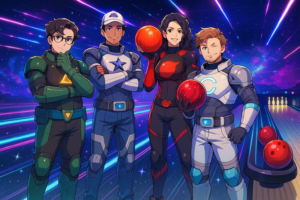AI art and music are quite amazing. In seconds, you can create fun images. To wit, below is a photorealistic image I created with ChatGPT of Adam Smith and David Hume having lunch and Hume sticking Smith with the bill:

Or a cartoon image of my summer bowling league team, the Cosmic Colonels:

Both of these had zero monetary cost. I told GTP what I wanted, it generated them, and now I can share them.
Among artists (by which I mean both those who generate art for art’s sake and those who generate art professionally, like graphic designers), AI is hotly controversial. Professional artists understandably fear that AI will take their jobs. Let’s use the “economic way of thinking” to analyze those fears and see what is most likely.
Let’s start with the most basic, uncontroversial economic thinking: that demand curves slope downward. That means that as price rises, quantity demanded falls (and vice versa).
AI is relatively cheap for the user (as low as $0) compared to professional artists, so the law of demand suggests that people will demand more art. This means people now demand original art for lower-marginal-benefit uses. A reason demand curves slope downward is the law of diminishing marginal utility: As one consumes more of a good, one gets less satisfaction from each unit consumed. Consequently, when acting as consumers, people seek to satisfy the highest marginal uses first and then move on to lower marginal uses. This is why when the price of something is high, it tends to be used for high marginal value tasks as opposed to low marginal value tasks.
So, as the price of art falls due to AI, more art is being consumed for low-marginal-benefit uses. Uses like: creating a cartoon image of a bowling team or imagining David Hume as a cheapskate and bad friend. These uses are not eliminating jobs because these images did not exist at a higher price; I am not paying an artist a commission to draw an image for a joke in a blog post.
But what of the higher-margin uses of art? At the lower price, could AI displace art that was previously supplying those uses, thus generating more consumer surplus (at the expense of producer surplus)? That certainly will happen, to some degree. Indeed, if the market were perfectly competitive (that is, if AI art were a perfect substitute for professional art), we should expect complete substitution of AI art for human-produced art.
But for high-marginal-use art, the goals are different. One isn’t making a cartoon image as an in-joke among friends, but producing commercial products, a customized portrait, or something else the person values highly. AI may be able to replicate some of those tasks, but not all. AI, for all its wonders, is not intelligent. It is a computer program. When dealing with AI, there is no “meeting of the minds” as with an artist. AI isn’t particularly good at interpreting human communication. It can be surprisingly difficult to get AI art to do what you want sometimes, and how it interprets prompts can be a mystery (even to the AI!). With a human artist, communication can be much easier.
Consequently, I expect the market to bifurcate. One branch will be the low-marginal-use art. That will flourish, but not cost any jobs. The other branch will be high-marginal-use art, where humans will likely still dominate. Where that bifurcation occurs will be where jobs are lost. The intramarginal[1] artist would likely lose their job to AI. Who they are and how many artists that represents, I cannot say. But I do not expect AI to be the existential crisis some consider it for art creation and the art industry.
——
[1] Reminder: I am using “marginal” here in the economic sense. These are artists who are operating right at the margin, right at the point of bifurcation. “Marginal” does not imply that they are low-talent. Rather, for whatever reason, the work they are producing is very close in value from the buyer’s perspective to what can be produced by AI.


